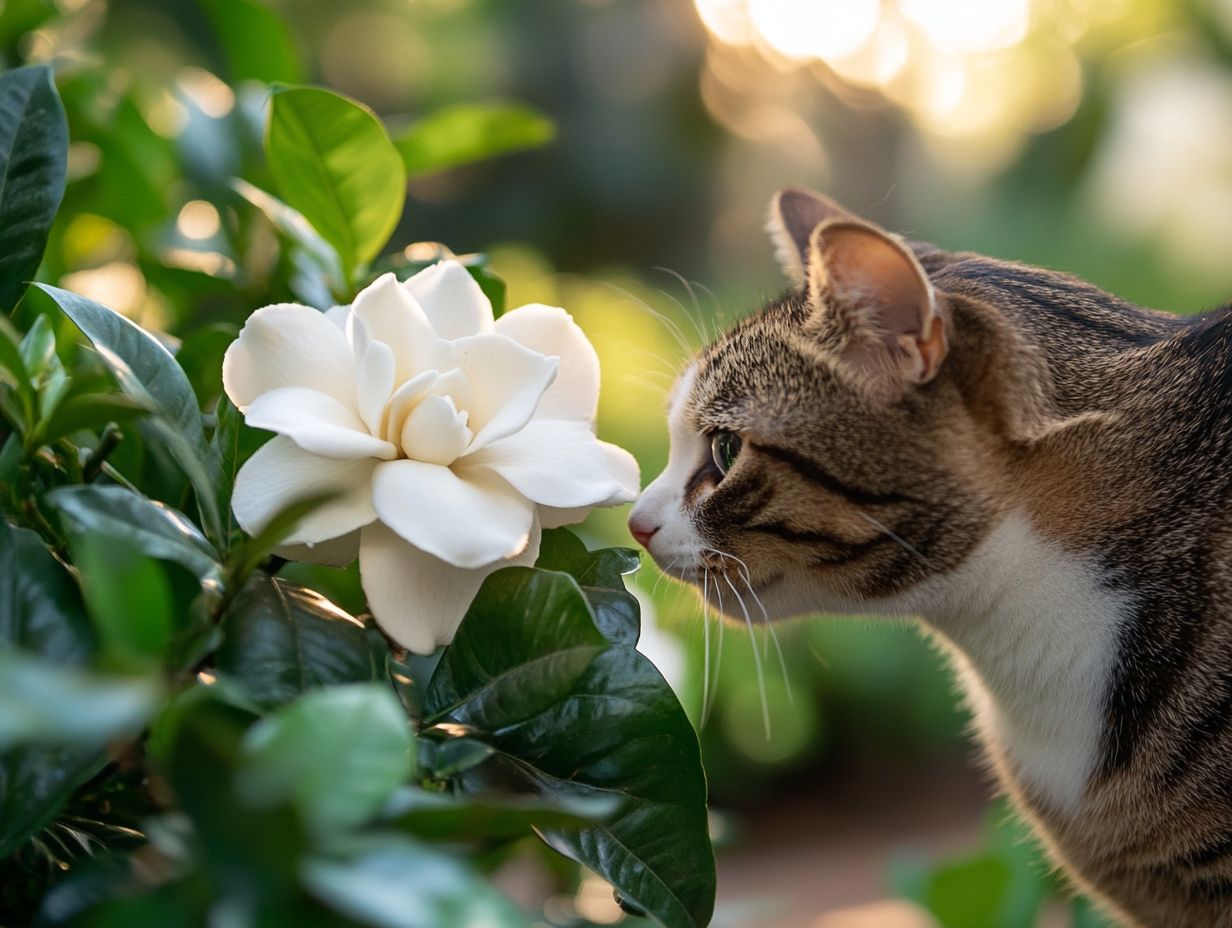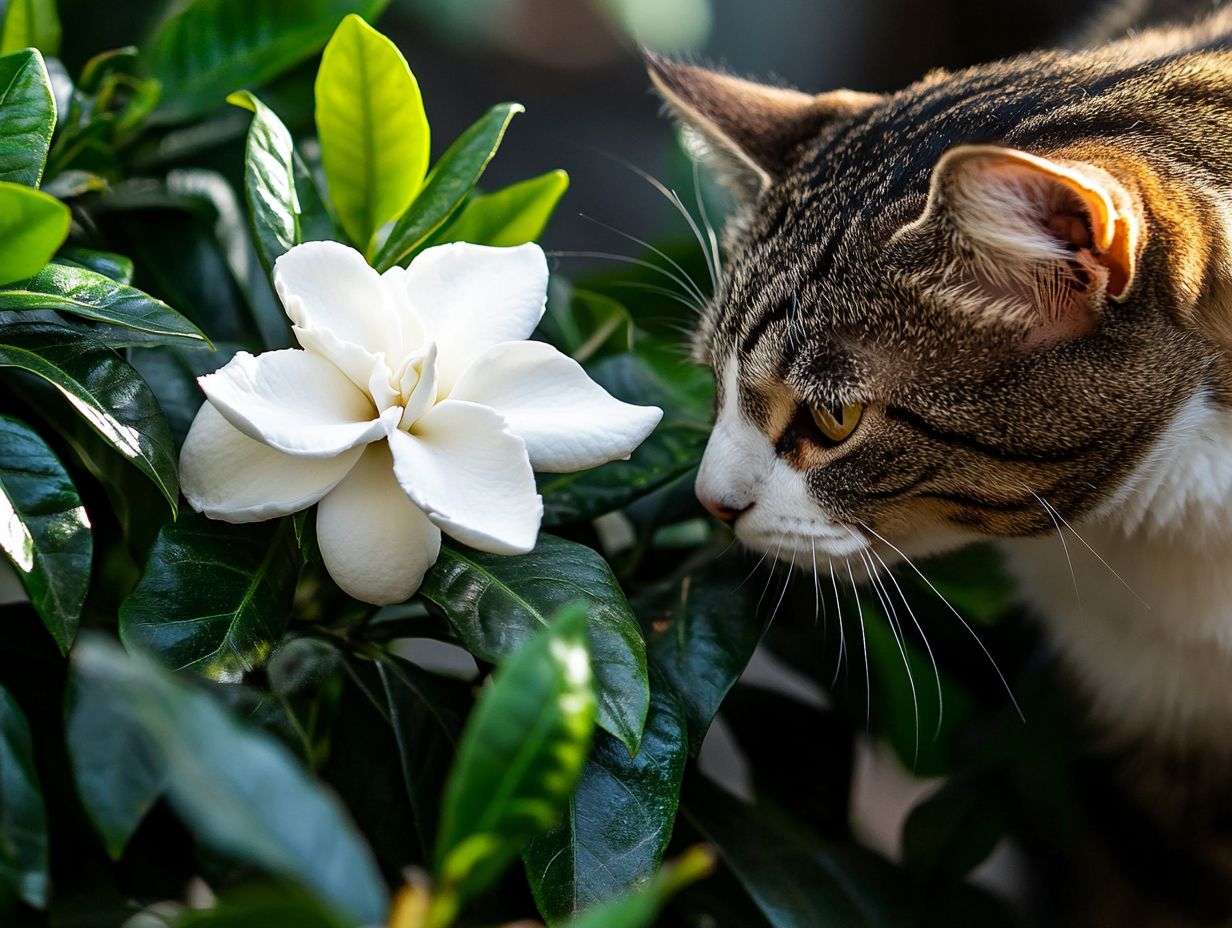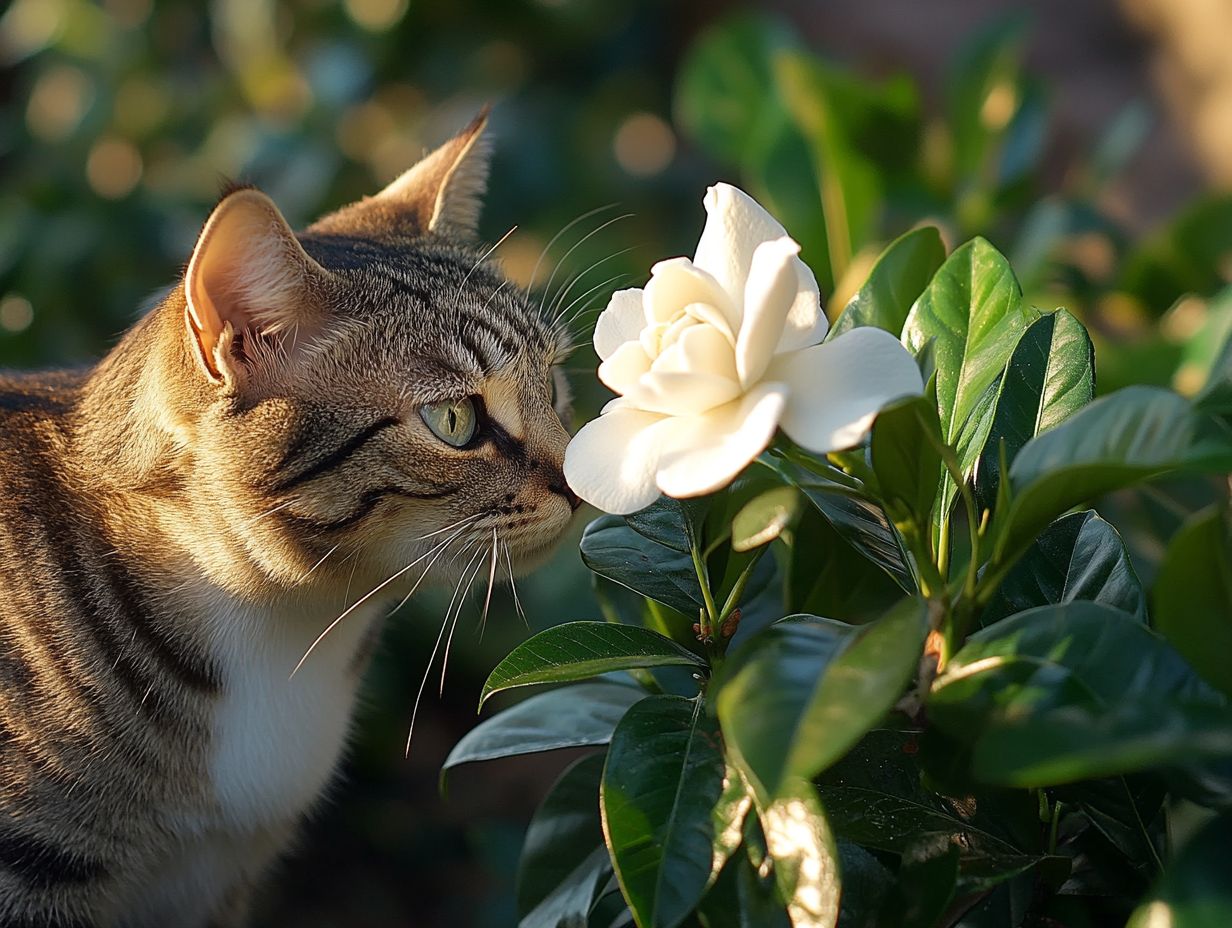Toxicity Level: Gardenias are considered toxic to cats.
Gardenias are beloved for their fragrant blooms and lush greenery, but if you’re a cat owner, you might be wondering about their safety.
Can these beautiful plants be harmful to your feline friend? This article explores the toxicity of gardenias for cats, including which parts are dangerous, the symptoms of poisoning, and what steps to take if your cat ingests any part of the plant.
It also discusses preventive measures and highlights other common plants that pose risks to your pet.
Stay informed to keep your cat safe!
Key Takeaways:

- Gardenias can be toxic to cats if ingested, causing symptoms such as vomiting, diarrhea, and difficulty breathing.
- All parts of the gardenia plant, including the flowers, leaves, and stems, contain toxic substances for cats.
- If your cat ingests gardenias or any other toxic plant, seek immediate veterinary care and try to identify the plant for proper treatment.
Can Gardenias Poison Cats?
Gardenias, particularly the species Gardenia jasminoides commonly found in Florida gardens, are beautiful and fragrant flowering plants. However, they pose a serious health risk to felines due to their toxic compounds such as saponins, geniposides, and gardenosides.
When ingested, these plants can cause vomiting and diarrhea in cats. Cat owners should be aware of the dangers associated with these plants and understand the appropriate actions to take immediately if ingestion occurs.
What Parts of the Gardenia Plant are Toxic to Cats?
The toxicity of Gardenia plants, commonly found in Florida, is present in the leaves, flowers, and stems. These compounds can harm cats if ingested.
These substances disrupt a cat’s digestive system, leading to a range of unpleasant symptoms. Common effects in cats that have consumed these plants include:
- Mild Symptoms: Drooling, lack of appetite
- Moderate Symptoms: Vomiting, diarrhea, excessive drooling, lethargy
- Severe Symptoms: Abdominal pain, respiratory distress, tremors, seizures
Cat owners should be vigilant about the presence of these plants in their pets’ environments.
For pet owners seeking information on plant toxicity, the ASPCA Animal Poison Control Center and veterinarians are excellent resources.
What Are the Symptoms of Gardenia Poisoning in Cats?
The symptoms of Gardenia poisoning in cats can vary significantly. They often begin with vomiting and diarrhea but may progress to severe behavioral changes and loss of coordination if not addressed promptly.
A veterinarian will provide the best treatment options tailored to the individual animal and ensure that these serious symptoms are closely monitored and effectively treated.
What Should You Do If Your Cat Ingests Gardenia?

If you suspect that your cat has consumed Gardenia, it is essential to contact your veterinarian or an emergency veterinary service immediately for guidance and treatment options to minimize the risk of toxicity.
First Aid Steps:
- Assemble key information, such as the amount of Gardenia ingested and the time of ingestion.
- Do not induce vomiting unless instructed by a veterinarian.
- Follow your veterinarian’s guidance closely.
Treatment options may include inducing vomiting, administering activated charcoal, and providing supportive care based on the severity of the situation. It is critical to seek treatment as soon as possible, as delaying action until symptoms appear can exacerbate the situation. For more information on the potential risks of gardenias to cats, you can read this article on Can Gardenias Poison Cats? A Vet’s Detailed Look.
How is Gardenia Poisoning in Cats Diagnosed?
Common Misconceptions: Many pet owners believe that gardenias are harmless to cats due to their beauty. This is a myth; gardenias can be toxic and should be treated with caution.
Prevention Tips:
- Keep gardenias out of reach of cats.
- Consider replacing gardenias with non-toxic plants.
- Educate yourself about other toxic plants.
Disclaimer: The information provided should not substitute for professional veterinary advice. Always consult your veterinarian for concerns regarding plant toxicity.
Last reviewed: October 2023. This content will be updated as new research findings regarding gardenia toxicity become available.
Is Gardenia Toxic to Cats?
Gardenia is considered mildly toxic to cats. The toxic compounds found in the gardenia plant include saponins and potentially others. All parts of the plant can be harmful if ingested.
Symptoms of Gardenia Poisoning in Cats
Symptoms of gardenia poisoning can be categorized by severity:
- Mild Symptoms: Vomiting, diarrhea
- Moderate Symptoms: Lethargy, abdominal pain
- Severe Symptoms: Respiratory distress, seizures, changes in heart rates
Both immediate and potential long-term health effects can occur, making awareness crucial for pet owners.
First Aid for Suspected Gardenia Poisoning
If you suspect your cat has ingested gardenia or any toxic plant, follow these steps:
- Stay calm and assess your cat’s condition.
- Remove any remaining plant material from their mouth.
- Contact your veterinarian immediately.
- Provide the veterinarian with details about the ingestion.
Prompt treatment can significantly improve your cat’s prognosis.
What is the Treatment for Gardenia Poisoning in Cats?
Treatment for Gardenia poisoning in cats varies based on the severity of symptoms and may involve immediate veterinary intervention, administration of activated charcoal, and supportive care to manage issues such as vomiting and diarrhea.
Veterinary professionals typically begin by assessing the cat’s condition through a thorough physical examination to determine the level of toxicity and the appropriate treatment course. In critical situations, intravenous fluids may be administered to prevent dehydration and maintain electrolyte balance.
Additionally, medications such as antiemetics may be provided to alleviate nausea and prevent further vomiting. Follow-up care is essential, as it allows the veterinarian to monitor recovery progress and adjust treatments as needed.
Pet owners are advised to closely observe their cats for any recurring symptoms, ensuring a prompt return to the clinic if complications arise.
How Can You Prevent Gardenia Poisoning in Cats?
Preventing Gardenia poisoning in cats requires creating a safe environment by removing toxic plants from your home and garden and opting for pet-friendly, non-toxic alternatives, such as catnip, grass, rosemary, and thyme.
Practical prevention tips include:
- Conducting thorough research on plant varieties before introducing them into your home.
- Consulting with local nurseries about pet-friendly options.
- Regularly reviewing the ASPCA’s list of poisonous plants.
While enhancing their living spaces, it is essential for cat owners to select non-harmful plants that promote their pets’ well-being.
Common Misconceptions about Gardenia
Many people believe Gardenia is completely safe for cats due to its pleasant fragrance. This misconception can lead to unintentional poisoning. Understanding the real risks associated with the plant is vital for responsible pet ownership.
What Other Plants are Toxic to Cats?

Plus gardenias, many common plants are toxic to cats, including lilies, oleander, and certain ferns. Therefore, it is essential for all pet owners to familiarize themselves with the ASPCA’s list of poisonous plants to ensure the safety of their cats.
What Should You Do If Your Cat Ingests a Toxic Plant?
If your cat has ingested a toxic plant, the most important step is to take them to a veterinarian as quickly as possible, as prompt treatment can significantly improve their prognosis and reduce the likelihood of severe poisoning symptoms.
Before heading to the veterinary clinic, it is essential to gather as much relevant information as possible. Identify the type of plant that was eaten and try to remember the time of ingestion, as these details will assist the veterinarian in making a more accurate assessment.
Special Considerations
Be aware that kittens, senior cats, or those with existing health conditions may be at higher risk for severe symptoms. Seasonal considerations, such as the presence of Gardenias during specific times of the year, also call for heightened awareness.
Seasonal Considerations
Gardenias are especially popular during the warmer months, making it crucial for cat owners to monitor their surroundings and ensure these plants are kept out of reach during this time.
Disclaimer: This content is intended for informational purposes only and should not replace professional veterinary advice. Always consult your veterinarian for medical concerns.
For emergency assistance, contact the ASPCA Animal Poison Control.
Content last updated: [Insert Date]. Regularly review information to stay informed as new research emerges.
If possible, take a sample of the plant or a picture of it. Additionally, bring any packaging or labels, as they may contain helpful information. It is also advisable to have local poison control numbers and your veterinarian’s phone number readily available.
If the cat is showing symptoms such as vomiting, lethargy, diarrhea, or any other unusual behaviors, make a note of these, as they can aid in diagnosis and treatment. Remaining calm while acting quickly is crucial.
How Can You Keep Your Cat Safe from Plant Poisoning?
You can prevent plant poisoning in cats by actively implementing prevention strategies. These include:
- Educating yourself about harmful plant species, including toxic plants like gardenias,
- Using physical barriers to limit access, thus reducing the risk of ingestion,
- Choosing non-toxic, cat-safe gardening alternatives such as indoor herbs and outdoor safe plants.
Prevention Strategies
- Regularly inspect your home and garden for any potentially toxic plants.
- Consider adopting cat-safe gardening practices.
- Consult with your veterinarian for recommendations on safe plants.
Frequently Asked Questions

Can Gardenias Poison Cats?
Yes, gardenias, specifically Gardenia jasminoides, contain compounds such as saponins, geniposides, and gardenosides [source needed: Veterinary Journal] which can be toxic to cats if ingested in large amounts. In places like Florida, these plants are common in gardens.
What Are the Symptoms of Gardenia Poisoning in Cats?
Symptoms of gardenia poisoning in cats may include:
- Mild: Drooling, loss of appetite
- Moderate: Vomiting, diarrhea
- Severe: Weakness, changes in behavior or coordination
Immediate action and consultation with a vet are advised.
How Much Gardenia is Toxic to Cats?
The level of toxicity depends on the amount of gardenia ingested and the weight of the cat. As a general rule, any amount of gardenia is considered toxic to cats, posing a significant risk to their health.
First Aid and Treatment
If you suspect your cat has ingested any part of the gardenia plant, it is important to seek immediate veterinary care or contact an emergency vet. The vet may induce vomiting or administer activated charcoal to help prevent absorption of the toxic compounds, including gardenosides.
Are There Any Safe Alternatives to Gardenias for My Cat-Friendly Garden?
Yes, there are many safe plants that can be used in your garden instead of gardenias. Some examples include catnip, mint, rosemary, thyme, spider plants, Gerber Daisies, and cat-friendly grasses. These are pet-friendly, non-toxic options that can enhance your garden’s greenery while ensuring feline safety.
Can Cats Be Allergic to Gardenias?
Yes, cats can be allergic to gardenias just like humans. If your cat shows signs of an allergic reaction after coming into contact with gardenias, consult with your vet for appropriate treatment.
Balanced Perspective
While gardenias are aesthetically pleasing and can enhance the beauty of a garden, it is crucial to consider their potential toxicity to pets. Cat owners should weigh the risks against the benefits and consider pet-friendly alternatives for a safer environment.
Common Misconceptions
There are several myths concerning gardenias and cats. One common belief is that gardenias are entirely safe, while in fact, they do contain toxic compounds. Another misconception is that only some parts of the plant are harmful; in reality, all parts of the gardenia can pose a risk. Always research and consult professionals when unsure.
Disclaimer: The information provided is for educational purposes and does not substitute for professional veterinary advice.
It is important to regularly review and update your knowledge regarding plant safety for cats. This article was last reviewed on [insert date].
Call to Action: Save or bookmark local poison control and veterinarian contacts to ensure proactive safety for your pets.
For more information, check out our related topics on safe plants for cats and symptoms of plant poisoning.